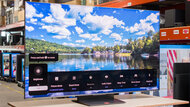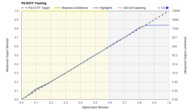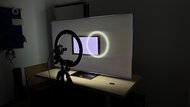Different TV technologies are available at the consumer level, each with advantages and disadvantages. One of those technologies is a quantum dot layer, which ensures a wide color gamut for vibrant and punchy colors. Other manufacturers have very wide color gamuts on their TVs without using quantum dots, but when a TV is branded as being a 'QLED,' it almost always has great colors. Learn more about QLED. There's also another type of TV that uses quantum dots with an OLED panel, known as QD-OLED, but they perform differently. You can read more about the differences between QD-OLED and QLED here. QLED and LED TVs are similar overall, but there are some differences.
Despite being known for excellent colors, a good QLED model also usually excels when it comes to peak brightness, making them suitable for use in bright rooms. With the rise of local dimming to increase contrast ratios, a good QLED TV also displays deep blacks, making them look good in a dark room, too. Through our testing procedures, we discover what QLED TVs are worth buying and which ones use the term to make them sound better than they really are.
Below are our recommendations for the best QLED TVs you can buy. Also, see our picks for the best LED TVs, the best TVs, and the best bright room TVs. You can also vote on which new models you want us to buy and test. To learn more about the current models on the market, check out our 2025 TV lineup page.
Quick Look






We buy and test dozens of TVs yearly, taking an objective, data-driven approach to deliver results you can trust. Our testing process is complex, with hundreds of individual tests that take over a week to complete. Most of our tests are done with specially designed test patterns that mimic real content, but we also use the same sources you have at home to ensure our results match the real-world experience. We use two main tools for our testing: a Colorimetry Research CR-100 colorimeter and a CR-250 spectroradiometer.
-
Best QLED TV
 Mixed Usage8.4Home Theater8.6Bright Room8.5Sports8.5Gaming7.7Brightness9.0Black Level8.7Color8.5Processing (In Development)8.7Game Mode Responsiveness6.5Resolution4kNative Refresh Rate120HzScreen FinishGlossyPanel TypeLEDSub-TypeVASee all our test resultsDolby VisionYes
Mixed Usage8.4Home Theater8.6Bright Room8.5Sports8.5Gaming7.7Brightness9.0Black Level8.7Color8.5Processing (In Development)8.7Game Mode Responsiveness6.5Resolution4kNative Refresh Rate120HzScreen FinishGlossyPanel TypeLEDSub-TypeVASee all our test resultsDolby VisionYesThe Sony BRAVIA 9 is the best QLED TV on the market. Its superb SDR brightness means it easily overcomes glare from the brightest indirect light sources, so as long as you don't have a lamp or window facing the screen, you aren't distracted by reflections on your TV screen. As impressive as this TV is in a bright room, it's also spectacular for use in a dark room. Its black levels aren't quite as good as an OLED, but it still has exceptional contrast that delivers incredibly deep, bold blacks for an LED TV, with essentially no haloing. It's also a great option for 4k Blu-ray collectors or those looking to get the most out of high-quality streaming services due to its support for Dolby Vision and DTS audio formats.
The TV's image processing is excellent, so low-quality and low-resolution content looks as good as it can. It's also very accurate in both SDR and HDR, delivering an image that respects the content creator's intent. Although its viewing angle is wider than most other QLEDs, it's still not good enough for wide seating arrangements, as its image quality degrades as you move off-center. The TV has HDMI 2.1 bandwidth, 4k @ 120Hz, and VRR, but there's noticeable motion blur in faster games, and it has higher input lag than competing models from other brands. You still get a solid gaming experience on this model, but it's not quite at the level of other high-end TVs on the market.
-
Best QD-OLED TV
 Mixed Usage8.9Home Theater9.0Bright Room8.8Sports8.8Gaming9.3Brightness8.7Black Level10Color9.1Processing (In Development)8.3Game Mode Responsiveness9.4Resolution4kNative Refresh Rate165HzScreen FinishMattePanel TypeOLEDSub-TypeQD-OLEDSee all our test resultsDolby VisionNo
Mixed Usage8.9Home Theater9.0Bright Room8.8Sports8.8Gaming9.3Brightness8.7Black Level10Color9.1Processing (In Development)8.3Game Mode Responsiveness9.4Resolution4kNative Refresh Rate165HzScreen FinishMattePanel TypeOLEDSub-TypeQD-OLEDSee all our test resultsDolby VisionNoAlthough this article mainly focuses on LED TVs that utilize a quantum dot layer, you might be hoping that there's an OLED TV that utilizes the color boosting technology, and that's exactly what the Samsung S95F OLED does. This model is the best of both worlds, as you get the vibrant, punchy colors that a QLED provides, combined with the perfect black levels you get with an OLED model. When you add that to the TV's amazing HDR brightness, you get a model that provides a very impactful and high-end HDR experience in a dark room. What's unique about this QD-OLED is its matte screen coating, which does an exceptional job of nearly eliminating reflections on the screen, making it a great TV to use in a bright room, too.
This TV certainly offers standout picture quality, even when compared to the Sony BRAVIA 9. Unfortunately, its low-quality content smoothing isn't as good as the Sony, and it doesn't support Dolby Vision or DTS audio passthrough, making it a bit less interesting for die-hard home theater fans. Thankfully, it has a much wider viewing angle than the Sony, so it's the TV to get for a wide seating arrangement. Like the Sony, it supports VRR technology to minimize tearing in games, and it supports up to 4k @ 165Hz on all four of its HDMI ports. It has the nearly instantaneous pixel response times that OLEDs are known for, which leads to clearer motion than any of the QLEDs on this list. It also has less input lag than the Sony, so it's a better choice for competitive gamers.
-
Best Mid-Range QLED TV
 Mixed Usage8.4Home Theater8.6Bright Room8.4Sports8.3Gaming8.4Brightness9.1Black Level9.2Color8.0Processing (In Development)7.8Game Mode Responsiveness8.0Resolution4kNative Refresh Rate144HzScreen FinishGlossyPanel TypeLEDSub-TypeVASee all our test resultsDolby VisionYes
Mixed Usage8.4Home Theater8.6Bright Room8.4Sports8.3Gaming8.4Brightness9.1Black Level9.2Color8.0Processing (In Development)7.8Game Mode Responsiveness8.0Resolution4kNative Refresh Rate144HzScreen FinishGlossyPanel TypeLEDSub-TypeVASee all our test resultsDolby VisionYesNo TV in this article really compares to the Samsung S95F OLED, since that TV is one of the few OLEDs on the market that utilize a quantum dot layer, and the rest of our picks are focused on purely QLED models. If you don't need an OLED and like what the Sony BRAVIA 9 offers, but you can't justify paying the Sony premium, go with the TCL QM8K. It's not quite as bright in SDR as the Sony, but it's still bright enough to overcome glare from indirect lighting. Just like the Sony, mirror-like reflections are visible on the screen, so avoid placing any light sources facing the screen. The TV's blacks are just as deep, albeit with a tiny bit more haloing around subtitles and highlights. Colors are equally as vibrant, but they aren't nearly as accurate, so you need to get the TV calibrated if you want the very best color accuracy.
The QM8K offers Dolby Vision, HDR10+, and DTS audio passthrough, so movie fans are completely covered in terms of formats. It has good processing overall, but it's not as good at upscaling, so you don't get the refined image you do on the Sony when watching low-resolution content. Sadly, its viewing angle is even narrower than the Sony's, so stay centered to the screen for the best image quality. Fortunately, the TV has better gaming performance than the Sony. It has two HDMI 2.1 ports, 4k @ 144Hz, 1080p @ 288Hz, and VRR. Not only does it offer higher refresh rates, but there's less motion blur on this TV, so motion in faster games looks crisper. Input lag is also a lot lower, so it offers a more responsive feel while gaming.
-
Best Lower Mid-Range QLED TV
 Mixed Usage7.8Home Theater7.9Bright Room8.0Sports7.9Gaming7.8Brightness7.8Black Level8.4Color7.5Processing (In Development)7.7Game Mode Responsiveness8.0Resolution4kNative Refresh Rate144HzScreen FinishGlossyTypeLEDSub-TypeVASee all our test resultsDolby VisionYes
Mixed Usage7.8Home Theater7.9Bright Room8.0Sports7.9Gaming7.8Brightness7.8Black Level8.4Color7.5Processing (In Development)7.7Game Mode Responsiveness8.0Resolution4kNative Refresh Rate144HzScreen FinishGlossyTypeLEDSub-TypeVASee all our test resultsDolby VisionYesIf the TCL QM8K is out of your price range, but you still want a TV that offers solid image quality and a ton of features, you can go with the cheaper TCL QM7K and still get a great TV overall. It offers the exact same gaming features as the more expensive TCL model, so you still get two HDMI 2.1 ports, support for 4k @ 144Hz, 1080p @ 288Hz, and VRR, so it's a great choice for both console and PC gamers. It also supports both HDR10+ and Dolby Vision, so you're set no matter which HDR format your content uses, and it passes through DTS audio, which is great for Blu-ray collectors. Its image processing isn't quite as good, so low-resolution looks a bit softer, and there are more details lost in low-bitrate content, but its overall processing certainly isn't bad.
Even though its overall image quality isn't quite at the same level as the QM8K, it's surprisingly close. While it's a bit dimmer than TCL's higher-end model, it's still bright enough to handle glare in well-lit rooms; as long as you don't place the screen directly in front of any light sources, reflections aren't an issue. Black levels aren't quite as good, but blacks still look bold and impressive, especially in darker environments, though there's a bit more haloing around highlights and subtitles. The TV isn't as bright as the QM8K in HDR, but it still delivers bright highlights that stand out well enough for an impactful HDR experience, especially when paired with its vibrant colors. Like the QM8K, its viewing angle is relatively narrow, so it's best to sit directly in front of the screen for the best experience.
-
Best Budget QLED TV
 Mixed Usage7.1Home Theater7.2Bright Room7.0Sports7.1Gaming7.2Brightness6.5Black Level7.6Color7.2Processing (In Development)7.0Game Mode Responsiveness7.9Resolution4kNative Refresh Rate144HzScreen FinishGlossyTypeLEDSub-TypeVASee all our test resultsDolby VisionYes
Mixed Usage7.1Home Theater7.2Bright Room7.0Sports7.1Gaming7.2Brightness6.5Black Level7.6Color7.2Processing (In Development)7.0Game Mode Responsiveness7.9Resolution4kNative Refresh Rate144HzScreen FinishGlossyTypeLEDSub-TypeVASee all our test resultsDolby VisionYesIf you like the features of the TCL QM7K but need something more budget-friendly, the TCL QM6K is the best budget option. It doesn't use a full-fledged quantum dot layer like the other models on our list, but colors still look vibrant enough that the image doesn't look dull or lifeless. Blacks aren't as bold, but since the TV has local dimming, blacks are still deep enough to give solid depth to the image, especially in a dark room. However, there's visible haloing, which means the area around highlights and subtitles glows, which causes them to bleed into surrounding blacks. The TV's handling of direct reflections is bad, but if you don't place any light sources opposite the screen, it's more than bright enough to overcome glare in a room with the overhead lights on. However, its lower HDR brightness means highlights don't stand out as much as they should in HDR content, but it still provides a decent HDR experience overall.
As with other TCL models, the viewing angle is on the narrow side, so sitting directly in front of the screen will give you the best image quality. It has worse image processing than the QM7K, so low-bitrate content is noisy, and there's a lack of fine details in low-resolution content. Luckily, you still get the same core gaming features found in its more expensive counterparts, as it still has two HDMI 2.1 ports, support for 4k @ 144Hz, 1080p @ 288Hz, and VRR. For movie fans, you still get Dolby Vision, HDR10+, and DTS audio passthrough, which is great for a budget model.
Notable Mentions
-
Sony A95L OLED:
The Sony A95L OLED delivers a similar experience to the Samsung S95F OLED, sharing the same underlying QD-OLED panel technology. The Sony offers Dolby Vision support and better processing, and you'll enjoy a more accurate movie-watching experience. However, the Samsung is better for bright rooms and offers a better gaming experience, making it more versatile.
See our review -
Sony BRAVIA 7:
The Sony BRAVIA 7 is a good choice for those who want a Sony TV but can't afford the pricey Sony BRAVIA 9. It has a narrower viewing angle, blacks aren't as deep, and it has noticeably worse reflection handling. However, you get similar brightness, the same gaming features, and almost identical image processing, so it's a good choice if you want a Sony model.
See our review -
Hisense U8QG:
The Hisense U8QG competes with the TCL QM8K, and the two TVs are similar overall. The Hisense is even brighter and has a slightly wider viewing angle, but it severely overbrightens HDR content. On the other hand, the QM8K has better black levels and better motion handling, and it offers a superior HDR experience, making it the better TV all-around.
See our review -
Hisense U75QG:
The Hisense U75QG is similar to the TCL QM7K, but it offers better peak brightness. Unfortunately, the Hisense makes HDR content look much brighter than intended and has more apparent motion blur due to its slower pixel transitions. Since the TCL offers clearer motion, has superior contrast, and offers 1080p @ 288Hz, it's the better TV overall.
See our review -
Hisense U65QF:
The Hisense U65QF competes with the TCL QM6K but offers more brightness. However, the Hisense really overbrightens HDR content, so it doesn't stay true to the content creator's intent. The TCL offers a more well-rounded experience, with better black levels, superior accuracy, 1080p @ 288Hz, and lower input lag.
See our review
Recent Updates
Nov 18, 2025:
We confirmed the accuracy of our current picks and ensured all products are in stock.
Aug 27, 2025:
Replaced the Samsung S90D with the Samsung S95F, the Hisense U8N with the TCL QM8K, the Hisense U7N with the TCL QM7K, and the Hisense U6N with the TCL QM6K. We dropped the 'Best Cheap QLED' category, since there are no current cheap models that actually utilize quantum dot technology. Finally, we updated the Notable Mentions section with newer models.
Apr 23, 2025:
Removed the TCL QM7/QM751G QLED from the Notable Mentions and mentioned it in the 'Best Lower Mid-Range QLED TV' category instead, since it's so close to the Hisense U7N. We also updated some text throughout the article for clarity.
Oct 07, 2024: Replaced the Hisense A6/A65K with the Hisense A7N in the 'Best Cheap QLED TV' category. We also swapped the Samsung S90C OLED, the Hisense U8/U8K, and the Hisense U6/U6K with their 2024 successors and updated the Notable Mentions.
All Reviews
Our recommendations above are what we think are currently the best quantum dot technology TVs to buy for most people depending on your budget and needs. We factor in the price (a cheaper TV wins over a pricier one if the difference isn't worth it) and availability (no TVs that are difficult to find or almost out of stock everywhere).
If you would like to do the work of choosing yourself, here is the list of all our TV reviews. Be careful not to get too caught up in the details. While no TV is perfect, most TVs are great enough to please almost everyone, and the differences are often not noticeable unless you really look for them. Also, keep in mind that our scores aren't comparable across different test benches, so the older TVs in the list below score higher than they would today.















